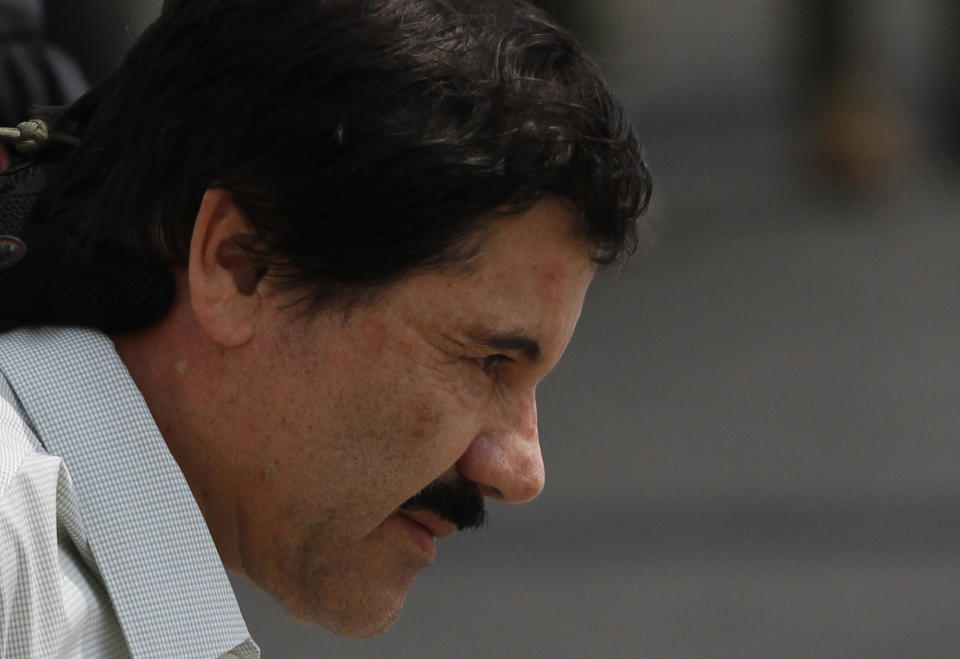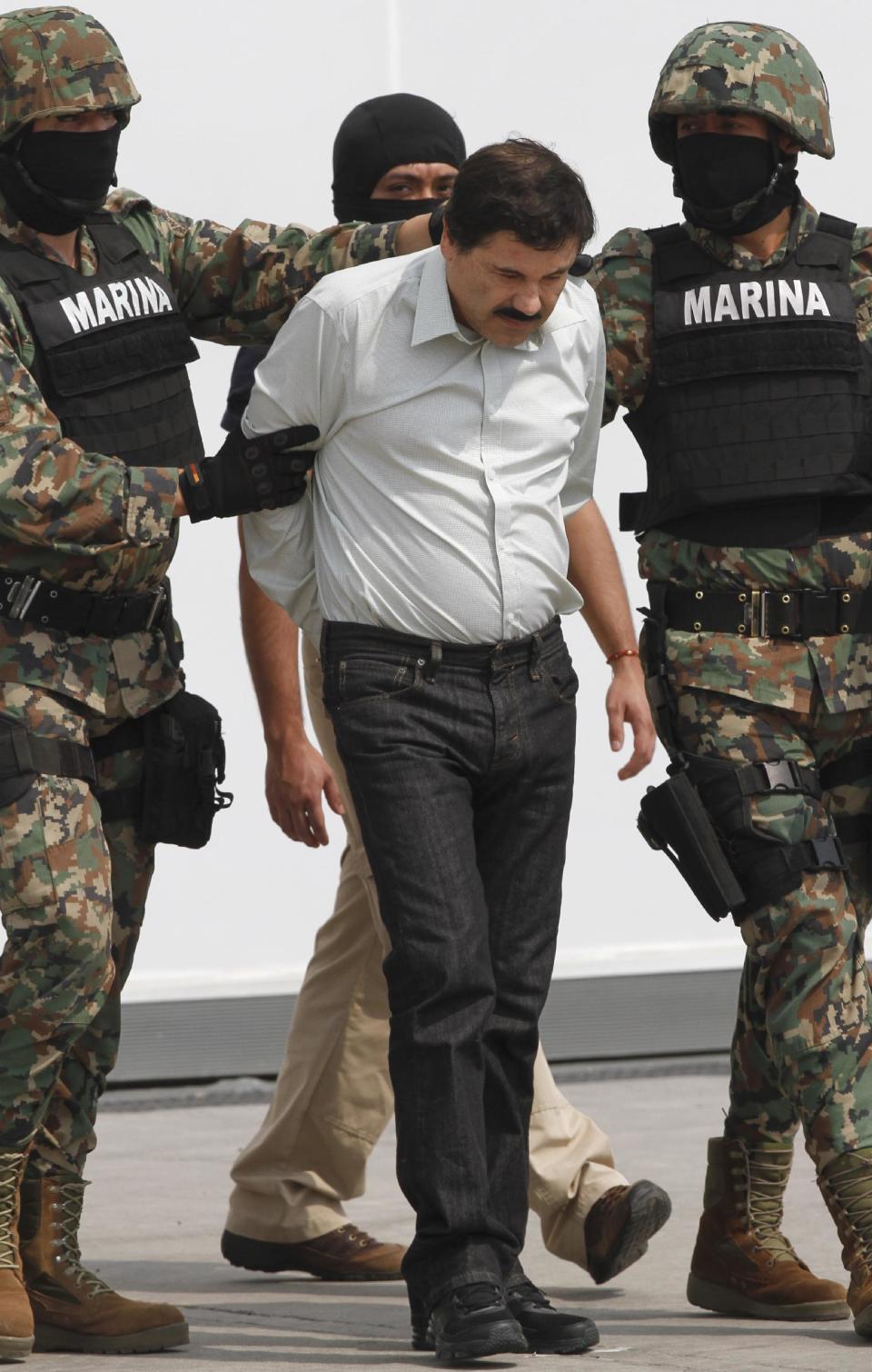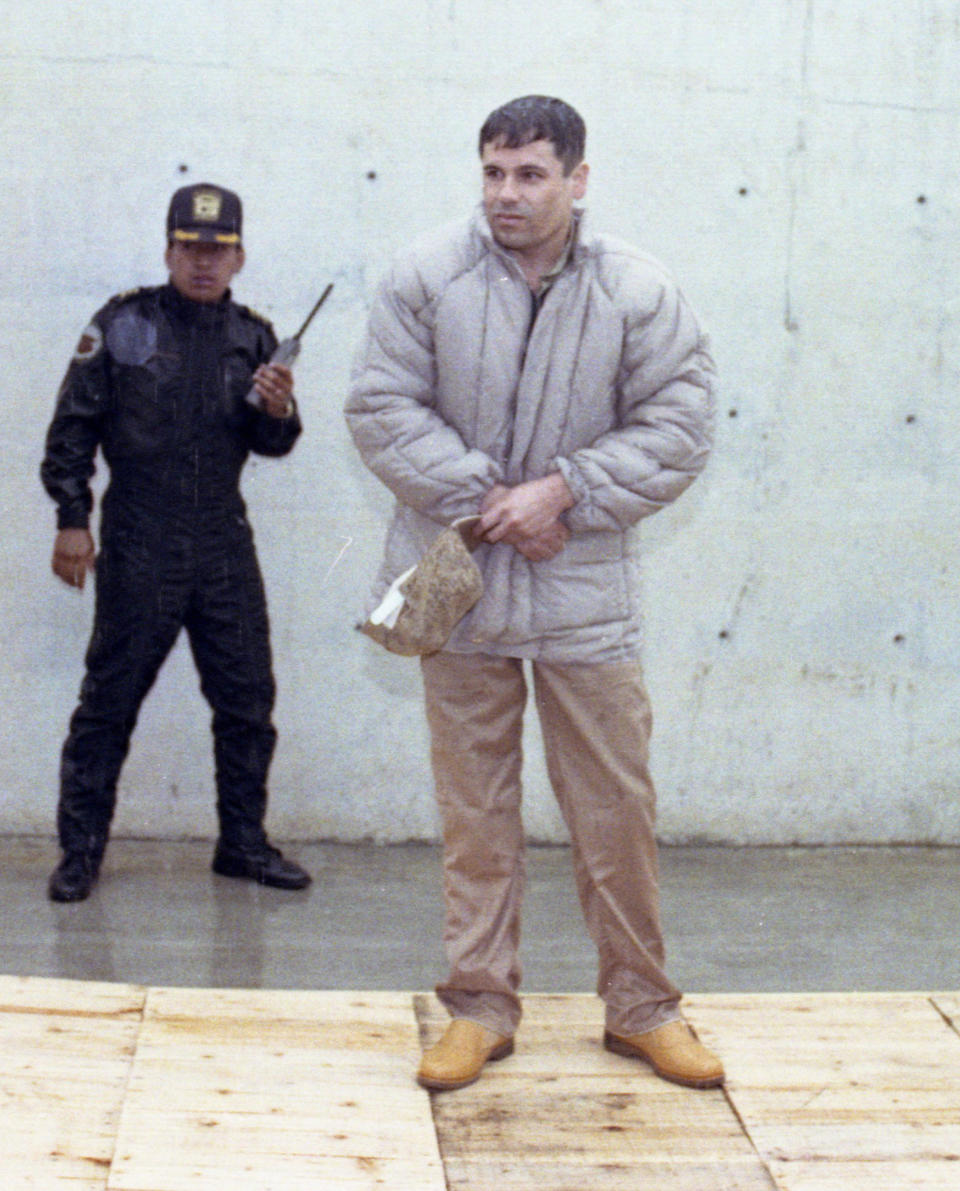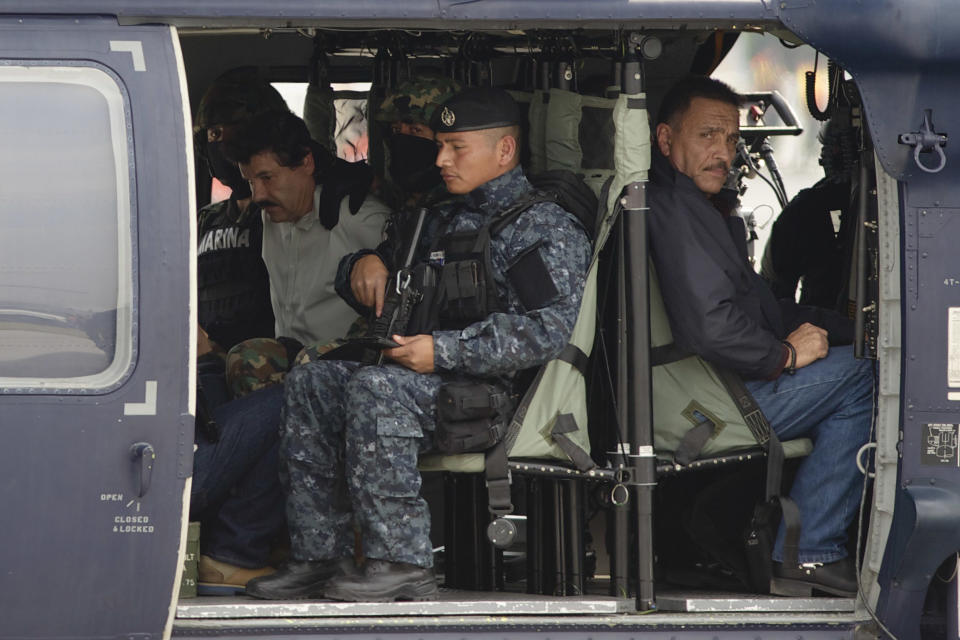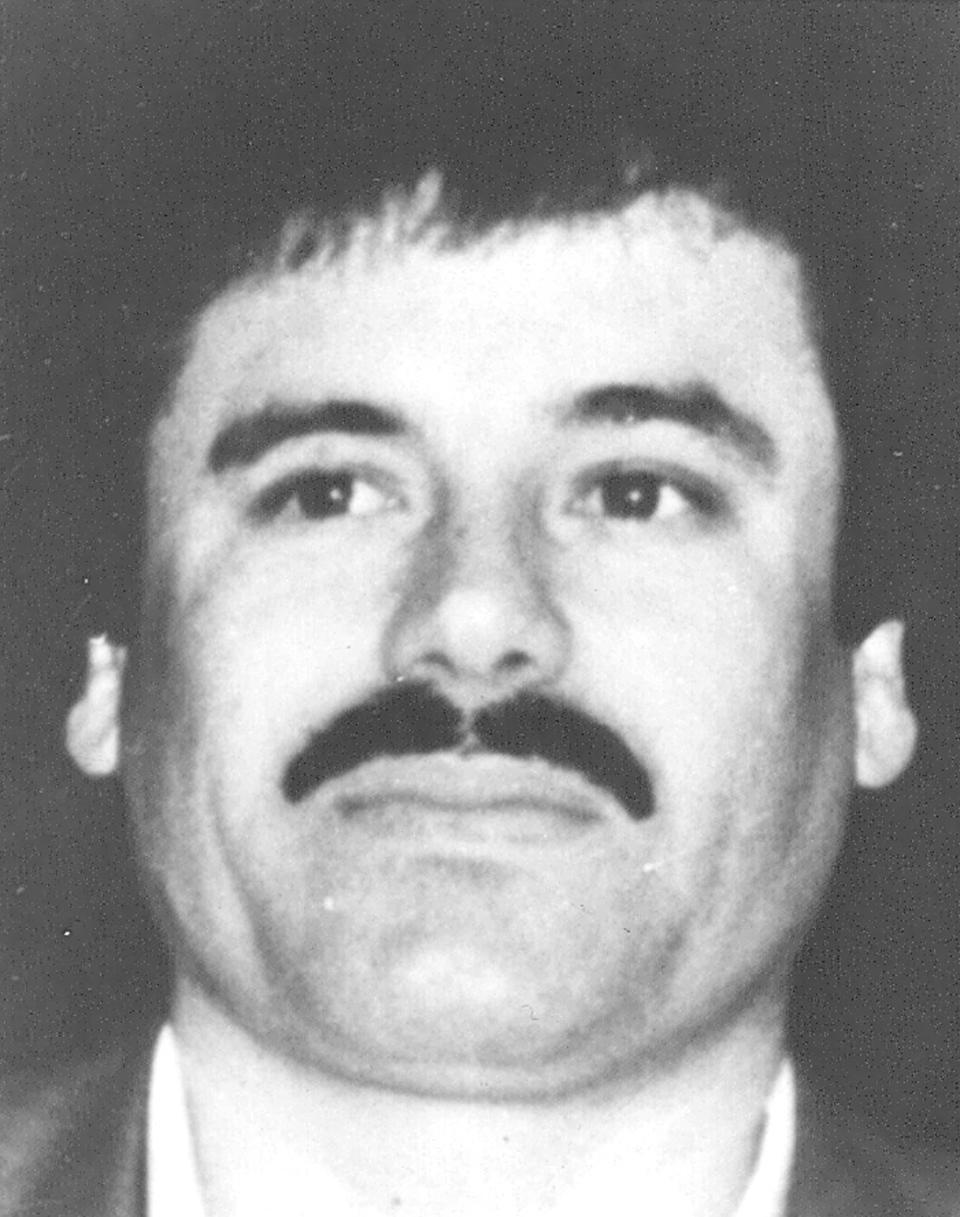Officials: Wiretaps, aides led to drug lord arrest
CULIACAN, MEXICO (AP) — As Mexican troops forced their way into Joaquin "El Chapo" Guzman's main hideout in Culiacan, the country's most powerful drug lord sneaked out of the house through an escape tunnel beneath the bathtub.
Mexican marines working with U.S. authorities chased him but lost the man known as "Shorty" in a maze of tunnels under the city, a U.S. government official and a senior law enforcement official told The Associated Press on Sunday.
It would be a short-lived escape for Guzman, who was captured early Saturday hiding out in a condominium in Mazatlan, a beach resort town on Mexico's Pacific Coast.
He had a military-style assault rifle with him but didn't fire a shot, the officials said. His beauty queen wife, Emma Coronel, was with him when the manhunt for one of the world's most wanted drug traffickers ended.
The officials spoke on the condition of anonymity because they were not authorized to discuss specific details of how U.S. authorities tracked down Guzman.
For 13 years Guzman watched from western Mexico's rugged mountains as authorities captured or killed the leaders of every group challenging his Sinaloa cartel's spot at the top of global drug trafficking.
Unscathed and his legend growing, the stocky son of a peasant farmer grabbed a slot on the Forbes' billionaires' list and a folkloric status as the capo who grew too powerful to catch. Then, late last year, authorities started closing in on the inner circle of the world's most-wanted drug lord. Bit by bit, they got closer to the crime boss.
Then on Feb. 16, investigators from Mexico along with the Drug Enforcement Administration, the U.S. Marshals Service and Immigration and Customs Enforcement caught the break they badly needed when they tracked a cellphone to one of the Culiacan stash houses Guzman used to elude capture.
The phone was connected to his communications chief, Carlos Manuel Ramirez, whose nickname is Condor. By the next day Mexican authorities arrested one of Guzman's top couriers, who promptly provided details of the stash houses Guzman and his associates had been using, the officials said.
At each house, the Mexican military found the same thing: steel reinforced doors and an escape hatch below the bathtubs. Each hatch led to a series of interconnected tunnels in the city's drainage system.
The officials said three tons of drugs, suspected to be cocaine and methamphetamine, were found at one of the stash houses.
An AP reporter who walked through one of the tunnels had to dismount into a canal and stoop to enter the drain pipe, which was filled with water and mud and smelled of sewage. About 700 meters (yards) in, a trap door was open, revealing a newly constructed tunnel. Large and lined with wood panels like a cabin, the passage had lighting and air conditioning. At the end of the tunnel was a blue ladder attached to the wall that led to one of the houses Mexican authorities say Guzman used as a hideout.
A day after troops narrowly missed Guzman in Culiacan, top aide Manuel Lopez Ozorio was arrested. The officials said he told investigators that he picked up Guzman, Ramirez and a woman from a drainage pipe and helped them flee to Mazatlan.
A wiretap being monitored by ICE agents in southern Arizona provided the final clue, helping track Guzman to the beachfront condo, the officials said.
The ICE wiretap proved the most crucial lead late last week as other wiretaps became useless as Guzman and his associates reacted to coming so close to being caught.
"It just all came together and we got the right people to flip and we were up on good wire," the government official said. "The ICE wire was the last one standing. That wire in Nogales. That got him (Guzman) inside that hotel."
Alonzo Pena, a former senior official at ICE, said wiretaps in Arizona led authorities to the Culiacan house of Guzman's ex-wife, Griselda Lopez, and to the Mazatlan hotel where Guzman was arrested.
The ICE investigation started about a year ago with a tip from the agency's Atlanta office that someone was crossing the border with about $100,000 at a time, said Pena, who was briefed on the investigation. That person led investigators to another cartel operative, believed to be an aircraft broker, and that allowed them to locate Guzman's communications equipment.
The senior law enforcement official said the Mexican marines deserve credit for taking Guzman alive and without either side firing a shot.
"We never anticipated, ever, that he would be taken alive," the official said.
It is not yet clear what will happen next to Guzman, except that he will be the focus of a lengthy and complicated legal process to decide whether Mexico or the U.S. gets to try him first.
In Mexico, he is likely to face a host of charges related to his role as head of the Sinaloa cartel, which is believed to sell cocaine, marijuana, heroin and methamphetamine in some 54 countries.
Grand juries in at least seven U.S. federal district courts, including Chicago, San Diego, New York and Texas, have already issued indictments for Guzman on a variety of charges, ranging from smuggling cocaine and heroin to participating in an ongoing criminal enterprise involving murder and racketeering.
Federal officials in Chicago were among the first to say they wanted to try Guzman. On Sunday, Assistant U.S. Attorney Steven Tiscione in Brooklyn became the second. In an email Sunday, Tiscione said his office would also be seeking extradition but it would be up to Washington to make the final call.
A Justice Department official, speaking on condition of anonymity because it's a matter of sensitive diplomatic discussions, said decisions regarding extradition have not been made.
When Guzman was finally in handcuffs, the man who eluded Mexican authorities for more than a decade looked pudgy, bowed and middle-aged in a white button-down shirt and beltless black jeans.
Now 56, he had been on the run since escaping from prison in 2001 in a laundry truck. During those 13 years, Guzman was rumored to live everywhere from Argentina to Mexico's "Golden Triangle," a mountainous, marijuana-growing region straddling the northern states of Sinaloa, Durango and Chihuahua.
Under his leadership, the Sinaloa Cartel grew deadlier and more powerful, taking over much of the lucrative trafficking routes along the U.S. border.
His undoing started late last year as authorities on both sides of the border arrested people close to Guzman and one of his two top associates, Ismael "Mayo" Zambada.
This month federal forces began sweeping through Culiacan, capital of the Pacific coast state of Sinaloa. They closed streets, raided houses, seized automatic weapons, drugs and money, and arrested a series of men that Mexican officials carefully described to reporters as top officials for Zambada.
On Feb. 13, a man known as "19," whom officials called the new chief of assassin for Zambada, was arrested with two other men on the highway to Mazatlan.
Four days later, a man described as a member of the Sinaloa cartel's upper ranks was seized along with 4,000 hollowed-out cucumbers and bananas stuffed with cocaine. In the middle of last week, a 43-year-old known by the nickname "20" and described as Zambada's chief of security, was arrested transporting more cocaine-stuffed produce.
By the middle of the week at least 10 Sinaloa henchmen had been seized.
The final strike came when marines closed the beachside road in front of the Miramar condominiums, a 10-story, pearl-colored building with white balconies overlooking the Pacific and a small pool in front. Smashing down the door of an austerely decorated fourth-floor condo, they seized Guzman a few minutes after the sun rose.
___
Associated Press writer Alicia A. Caldwell reported this story from Washington and Adriana Gomez Licon reported in Culiacan. AP writers Katherine Corcoran in Mexico City and Elliot Spagat in San Diego contributed to this report.
___
Alicia A. Caldwell on Twitter: www.twitter.com/acaldwellap
Adriana Gomez Licon on Twitter: www.twitter.com/agomezlicon


